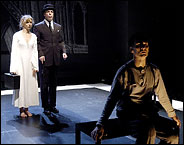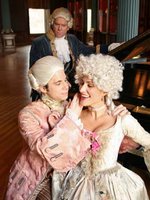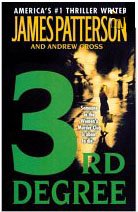
“Fears of Your Life, Study 1,” based on a book by San Francisco author Michael Bernard Loggins, and directed and choreographed by MFA Candidate Kim Epifano, is a true interactive work of theater.
As the audience enters the Mondavi Center, they are free to enjoy a display of artwork by members of Creativity Explored, a San Francisco-based visual art community for people with developmental disabilities, or watch portions of a video, “Life Itself,” by Francis Kohler and Todd Herman, about the life of Michael Bernard Loggins.
From there, the audience passes into the Mondavi Studio Theater, where everyone is invited to “leave their fears at the door,” by writing them on the large wall of butcher paper. The fears range from the serious (“Fear that my daughter will die,” “Fear that I will never again experience love”) to the less serious (“Fear of oversleeping,” “Fear of Dick Cheney”).
Next everyone is invited to choose from among a number of cartoon characters made of thick foam board, with velcro backing, and to, in essence, become part of the set-design team by placing the figures on the walls of set itself. The stage is lined with white felt, on which are drawn cartoonesque figures--a large television, which is running movie clips; a tall house, at the top of which is window in which sits actor Lonnie Ford, as Loggins himself, scribbling fears on pieces of paper, reading them aloud and then tossing them down onto the audience.
The audience is free to wander around the stage, picking up the pieces of paper, and reading Michael’s fears; examining the shoes on which are printed more fears; or checking out the larger than life puppets (designed and constructed by Michael Stasiuk), which will later become part of the choreography.
As starting time approaches, the lights begin to dim, the audience is invited to take their seats, and the show gets underway.
Ford, as Loggins, comes onto the stage with the dancers, members of Oakland’s Axis Dance Company – Judith Smith, Stephanie Bastos, Katie Faulkner, Sonsherée Gilese, Sean McMahon, and Renee Elisabeth Waters.
Inside the giant puppets, outside the giant puppets, on crutches, in wheelchair, running, dancing, leaping about, or rolling on the floor, the company energetically and effectively depicts the 138 fears listed in Loggins’ initial ‘zine. This is a work to which everyone can relate. Who hasn’t, at some time in their life, been afraid of a snake under the bed or going to the dentist?
“Fears of Your Life” is a multi-media event, incorporating movie projections (video design by Erich Bolton) and delightful animation by Todd Herman, bringing Loggins’ engaging drawings to life.
In spots there is definable music--songs written by Epifano and Katie Faulkner, and sung by Faulkner (accompanying herself on the guitar); in other spots there is what Epifano describes as “sound scape” or “vocal motion,” each type of music appropriate to the set of fears being examined. Sound designer Rick Scholwin does an exceptional job of handling the varied sounds.
Lighting plays an integral role in this production and Ron Reisner’s design beautifully portrays the mood, from the red color of traffic-related fears to the stark white fear of “panic attack,” or any of a number of moods in between, lighting only enhances the effect.
As for the performers themselves, they take us to familiar places, funny places, dark places, secret places. The combination of physically abled and disabled dancers, and of Michael Loggins, a developmentally disabled artist and writer, in such a seamless, beautiful manner erases the lines between our differences. We no longer see Michael, the disabled man. We see Michael the artist, the poet, the philosopher, the man. We don’t see physical disabilities of Judith and Stephanie, we see the beauty of dancers who move in a manner different from what we normally expect. We don’t see crutches, we see wings.
“Fears of Your Life, Study 1" is a unique theatrical piece which appeals to people on many different levels. It is a piece to which we can all relate and we leave the theater feeling a little less alone in our fears.
Which was, of course, why Michael Bernard Loggins wrote his little book in the first place.
 Our previous experience at Derf's had been a good one, and we had no reason to believe that this would be any different.
Our previous experience at Derf's had been a good one, and we had no reason to believe that this would be any different.




